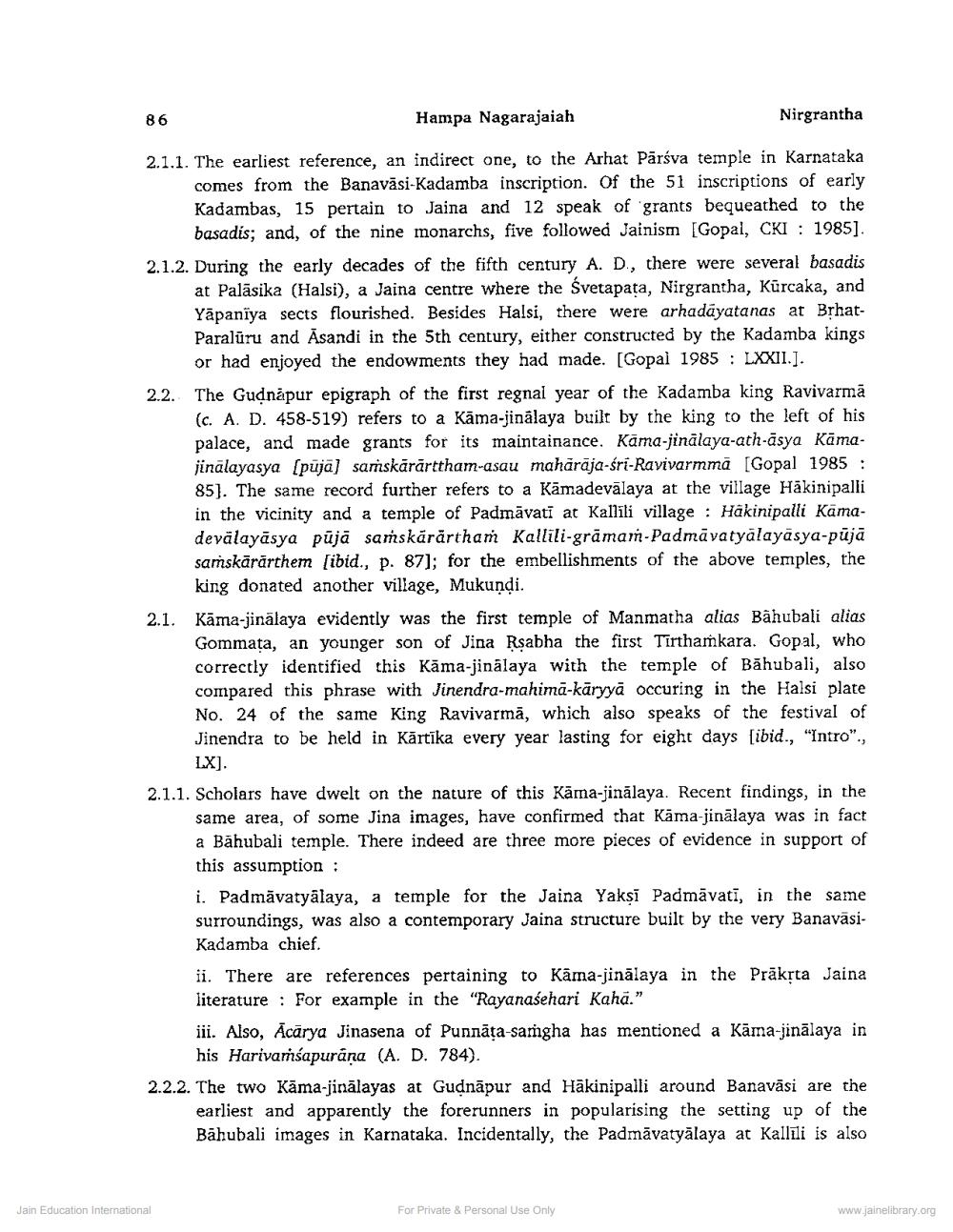Book Title: Jin Parsva and His Temples in Inscriptions of Karnataka Author(s): Hampa Nagrajaiha Publisher: Z_Nirgrantha_1_022701.pdf and Nirgrantha_2_022702.pdf and Nirgrantha_3_022703.pdf View full book textPage 3
________________ 86 Hampa Nagarajaiah Nirgrantha 2.1. 2.1.1. The earliest reference, an indirect one, to the Arhat Pārśva temple in Karnataka comes from the Banavāsi-Kadamba inscription. Of the 51 inscriptions of early Kadambas, 15 pertain to Jaina and 12 speak of grants bequeathed to the basadis; and, of the nine monarchs, five followed Jainism [Gopal, CKI : 1985]. 2.1.2. During the early decades of the fifth century A. D., there were several basadis at Palāsika (Halsi), a Jaina centre where the Śvetapata, Nirgrantha, Kürcaka, and Yapanïya sects flourished. Besides Halsi, there were arhadāyatanas at BrhatParalūru and Asandi in the 5th century, either constructed by the Kadamba kings or had enjoyed the endowments they had made. [Gopal 1985 : LXXII.]. 2.2. The Gudnapur epigraph of the first regnal year of the Kadamba king Ravivarmā (c. A. D. 458-519) refers to a Kāma-jinalaya built by the king to the left of his palace, and made grants for its maintainance. Kama-jinālaya-ath-asya Kamajinalayasya [puja) samskararttham-asau maharaja-śri-Ravivarmma (Gopal 1985 : 85). The same record further refers to a Kamadevālaya at the village Häkinipalli in the vicinity and a temple of Padmāvati at Kallili village : Häkinipalli Kamadevälayāsya pūjā saskārārtham Kallili-grāmam-Padmāvatyalayasya-pūjā samskārārthem (ibid., p. 87); for the embellishments of the above temples, the king donated another village, Mukundi. Käma-jinälaya evidently was the first temple of Manmatha alias Bahubali alias Gommata, an younger son of Jina Rsabha the first Tirthamkara. Gopal, who correctly identified this Kāma-jinālaya with the temple of Bāhubali, also compared this phrase with Jinendra-mahimā-kāryyā occuring in the Halsi plate No. 24 of the same King Ravivarmā, which also speaks of the festival of Jinendra to be held in Kārtīka every year lasting for eight days (ibid., "Intro"., LX]. 2.1.1. Scholars have dwelt on the nature of this Kāma-jinālaya. Recent findings, in the same area, of some Jina images, have confirmed that Kama-jinālaya was in fact a Bāhubali temple. There indeed are three more pieces of evidence in support of this assumption : i. Padmavatyālaya, a temple for the Jaina Yakși Padmavati, in the same surroundings, was also a contemporary Jaina structure built by the very BanavāsiKadamba chief. ii. There are references pertaining to Kāma-jinālaya in the Prākta Jaina literature : For example in the "Rayanasehari Kaha." iii. Also, Ācārya Jinasena of Punnāta-samgha has mentioned a Kāma-jinālaya in his Harivarśapurana (A. D. 784). 2.2.2. The two Kāma-jinālayas at Gudnāpur and Hākinipalli around Banavāsi are the earliest and apparently the forerunners in popularising the setting up of the Bāhubali images in Karnataka. Incidentally, the Padmāvatyālaya at Kallīli is also Jain Education International For Private & Personal Use Only www.jainelibrary.orgPage Navigation
1 2 3 4 5 6 7 8 9 10 11 12 13 14 15 16 17 18 19 20 21 22 23
